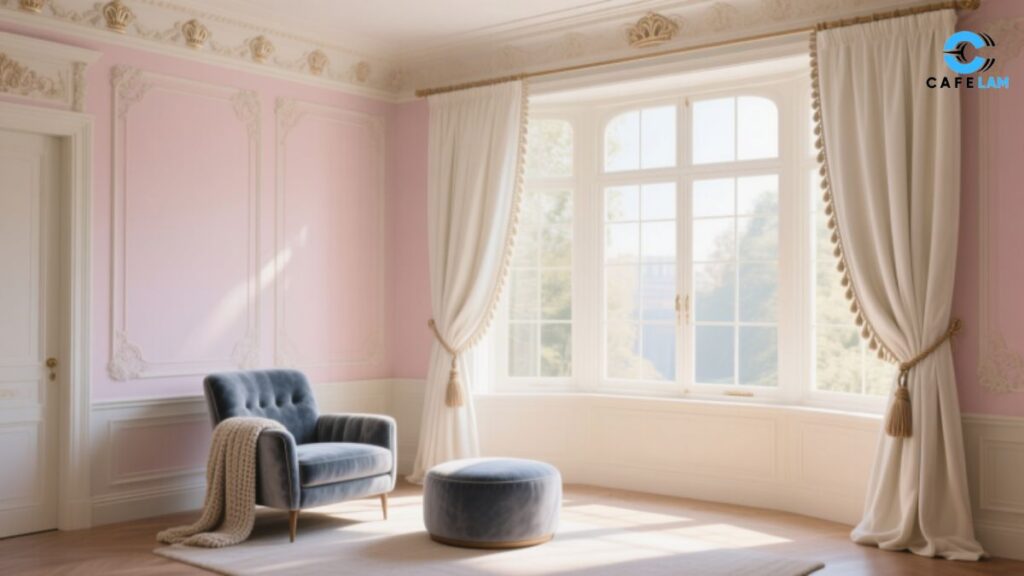Crown molding window trim is an often-overlooked detail in home design, yet it can drastically change the look and feel of a room. Whether you’re renovating your entire space or simply updating the window frames, the addition of crown molding can elevate your interiors, adding a touch of elegance, sophistication, and warmth. In this article, we’ll explore what crown molding window trim is, its benefits, and how to incorporate it into your design.
What is Crown Molding Window Trim?
Crown molding is a decorative trim placed at the top of a wall or around a window frame. It’s typically made from wood, plaster, or modern materials like polyurethane or MDF. The molding is designed to give the transition between the wall and ceiling a more finished, polished appearance. When added to window trim, it gives a custom, high-end look that enhances both the architectural features and the overall aesthetics of your space.
The window trim, on its own, frames your windows to create clean, sharp lines. When paired with crown molding, however, it introduces a layered effect, creating a sense of grandeur. The combined trim and molding emphasize the window as a focal point in the room and bring depth to the surrounding walls. It’s a simple addition, but it can significantly impact the design and style of your space.
The Benefits of Crown Molding Window Trim
-
Enhanced Aesthetic Appeal: The primary benefit of crown molding window trim is its visual appeal. Whether your interior style is traditional, modern, or transitional, crown molding adds a layer of sophistication. It can transform a plain, flat wall into something with dimension and architectural interest. Crown molding also helps in tying together various design elements within the room, especially if you’re using complementary finishes in other areas of the space.
-
Creates a High-End Look: When you add crown molding to your window trim, it instantly gives the room a more luxurious and custom look. The fine detail and craftsmanship associated with crown molding create the impression of a more expensive space, even on a modest budget. It’s a small touch that can make a huge difference in the overall feel of your home.
-
Increases Home Value: If you’re planning to sell your home, adding crown molding window trim can be a smart investment. Buyers often appreciate the added elegance that such details bring. It’s a design feature that’s associated with well-maintained, thoughtfully designed homes, which can make your property more appealing and increase its market value.
-
Conceals Imperfections: If your window frames are slightly uneven or the walls are not perfectly aligned, crown molding can cover up these small imperfections. It provides a clean and finished edge, hiding flaws that might otherwise be noticeable.
-
Customization Options: Crown molding comes in many shapes, sizes, and materials, giving you the ability to select a style that fits your taste and the overall design of your room. Whether you want a traditional, ornate style or a sleek, modern design, crown molding can be customized to suit your specific needs.
How to Choose the Right Crown Molding Window Trim
Selecting the right crown molding for your window trim requires a bit of planning. Here are a few factors to consider:
-
Room Style: The style of the room is one of the most important considerations when choosing crown molding. For example, a room with a more traditional style may benefit from detailed, ornate molding, while a modern space might look better with simpler, more minimalistic designs.
-
Material: Crown molding is available in a range of materials, from wood to composite and plaster. Each material offers its own set of advantages. Wood is a classic option and works well in traditional designs, while MDF (medium-density fiberboard) or polyurethane are cost-effective alternatives that are easier to install.
-
Scale of the Room: The size of the room plays a big role in determining the type and scale of crown molding you should use. In larger rooms, you can go with a more dramatic, larger profile, whereas in smaller rooms, a simpler, subtler molding will work better.
-
Window Size: When adding crown molding to your window trim, it’s important to consider the size of your windows. For large windows, you may want a more substantial molding that complements the scale of the window, while smaller windows can be paired with a finer, simpler design.
How to Install Crown Molding Window Trim
Installing crown molding window trim can be a rewarding DIY project, but it does require some precision and skill. If you’re planning to install it yourself, here’s a general overview of the steps:
-
Measure and Cut the Molding: The first step is to measure the length of your window frame and determine how much molding you’ll need. Use a miter saw to cut the molding at the appropriate angles, making sure each cut is precise. If you’re working with a corner, you’ll need to measure and cut the molding to fit.
-
Prepare the Window Frame: Ensure that the window frame is clean and dry before starting. If there are any existing trims, you’ll want to remove them carefully to create a clean surface.
-
Attach the Molding: Apply wood glue to the back of the molding and press it firmly against the window frame. Use finishing nails to secure it in place. Make sure the molding is flush against the wall and window frame to avoid gaps.
-
Fill the Gaps: Once the molding is attached, fill any gaps or nail holes with wood filler. Allow it to dry before sanding it smooth.
-
Paint or Stain: After the molding is installed and the gaps are filled, you can paint or stain it to match your room’s design. If you’re using wood molding, a rich stain will bring out the natural grain of the wood, while a fresh coat of paint can make the molding look crisp and clean.
Ready to take things further? Discover our full library of content.
Design Ideas for Using Crown Molding Window Trim
Crown molding window trim can be used in a variety of ways to enhance the beauty of your home. Here are some design ideas to inspire you:
-
Contrast with Wall Color: If you have a light-colored wall, consider using a dark, contrasting crown molding. This can create a striking visual effect and draw attention to the window trim.
-
Pair with Window Treatments: Combine crown molding window trim with elegant window treatments like curtains or Roman shades. This can create a cohesive, luxurious look.
-
Highlight Architectural Features: If your windows are a focal point in the room, use crown molding to emphasize their beauty. For example, you can pair it with detailed trim or a shelf to create a more dramatic effect.
-
Subtle Accent: For a more understated look, use simple, clean lines with crown molding to complement other design elements in the room. This is especially effective in modern or minimalist spaces.
Conclusion:
Crown molding window trim is a fantastic way to enhance the look of your home. It offers a variety of benefits, from aesthetic appeal to increased property value. Whether you are embarking on a full-scale renovation or simply updating the windows in your living room, adding crown molding can help create a polished, high-end look that transforms any room. By carefully selecting the right materials and styles, you can create a design that complements your home’s architecture and elevates your space to new heights.
Frequently Asked Questions (FAQs)
Is crown molding window trim hard to install?
While it requires some skill and precision, it’s not overly difficult for those with basic DIY experience. With the right tools and a steady hand, most homeowners can install crown molding themselves.
Can I use crown molding in every room?
Yes, crown molding can be used in any room of your home, from living rooms and bedrooms to kitchens and bathrooms. Just be mindful of the room’s style and size when selecting the molding.
How much does crown molding window trim cost?
The cost of crown molding varies depending on the material, style, and size of your windows. On average, you can expect to spend anywhere from $1 to $8 per linear foot for the molding itself, not including installation costs.
Can crown molding be painted?
Yes, crown molding can be painted. In fact, painting your molding is a great way to customize it and match the rest of your room’s decor.
How do I maintain crown molding window trim?
To maintain your crown molding window trim, clean it regularly with a soft cloth and mild cleaner. If it’s painted, touch up any chips or scuffs with matching paint.







